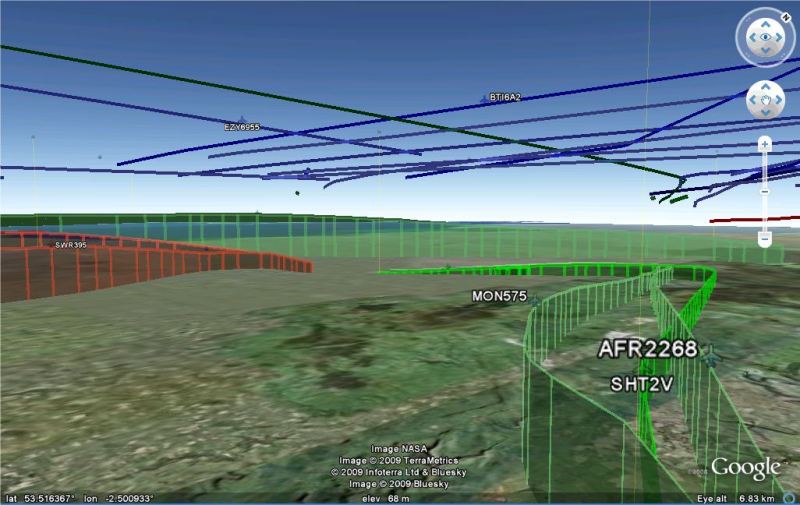SquawkBox now creates Google Earth files to give that 3D experience and providing a chance for you to share your airspace with others by sharing files.

SquawkBox can create kml files for viewing in Google Earth so you can see your flights and the paths that they take. Flights are colour-coded just like RadarBox, green for descending, red for ascending and blue for level flight. The files generated can take three forms;
Static files containing flight paths collected over a period of time.(
http://www.gfrost.co.uk/SquawkBox/Manchester_flight_paths_05L_operation.kmz is an example file of the flight paths at Manchester airport, 05L operation, UK with en-route navigational aids added).
Files with animated flight paths for flights collected over a period of time.(
http://www.gfrost.co.uk/SquawkBox/Manchester_flights_example_movie.kmz is an example file of an animated flight paths file with 25 minutes worth of flights near Manchester airport, UK, 23R operation.
http://www.gfrost.co.uk/SquawkBox/Manchester_flights_in_movie_plus_sigpoints.kmz is the static flight paths file corresponding to this animated file but with the UK's significant navigational points added along with other navigational aids).
A continously updated file showing the current positions of flights as output on Port 30003. (
http://www.gfrost.co.uk/SquawkBox/Manchester_live_flights.kmz is an example file of what you can expect to see when viewing flights as they are output on port 30003. The data has been collected near Manchester airport, UK and set to show the full length of the detected flight paths. No navigational aids are added).
SquawkBox collects the data for these Google Earth files by saving all flights that it has positional data for as it runs. Data is stored up to a fixed storage maximum at which time older flights are deleted as new ones are saved. When the program has been running for a while (probably at least 10 minutes) you can get the program to output these saved flights to a Google Earth kml file via SquawkBox's system menu option
Google Earth.
SquawkBox can also add the postions of navigational aids to the Google Earth terrain so you can see how aircraft steer towards various points (currently only VORs and NDBs are shown). In these days of satellite navigation it is questionable how much these contribute to the experience, but from my own experiences Manchester VOR seems to get plently of use with the VORs at Pole Hill and Trent being used for approach. If nothing else, it is perhaps interesting to see a VOR station pin-pointed in Google Earth.
The VORs/NDBs added are intended to be almost invisible when viewed from above, however if you tilt the viewpoint then you can see flight paths in relation to navaid positions. As far as navigational aids go, only a handful of countries have so far been included with SquawkBox, but more can be fairly easily added, just make a request or send me a pm. Currently only significant points for the UK are available (unless I find data for other countries).
If you don't use SquawkBox because it doesn't support the squawk codes of your country but want to make use of this Google Earth feature then you can always run it minimized and access SquawkBox's
GoogleEarth menu option by right-clicking on its icon when minimized.
The usual download site applies,
http://www.gfrost.co.uk/SquawkBox/, note however that directories are now included in the archive so you will have to remember to extract with
Use Folder Names to get the correct directory structure. It can be safely unzipped over the current version.
Have fun!
